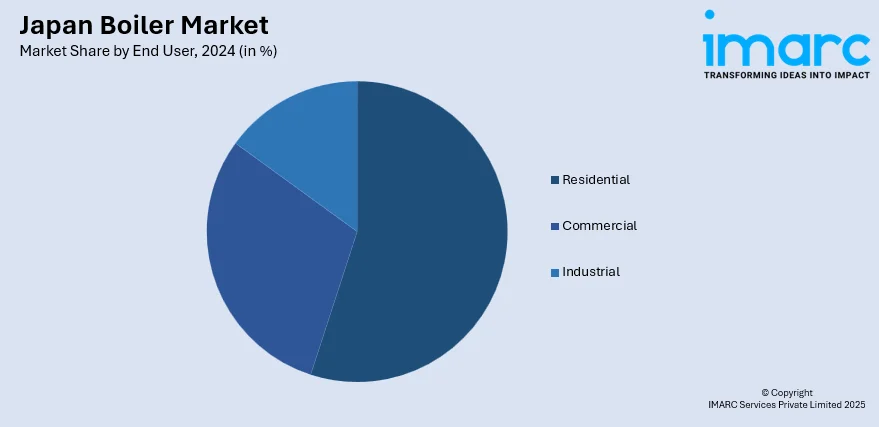
Japan Boiler Market Size, Share, Trends and Forecast by Boiler Type, End User, and Region, 2025-2033
Japan Boiler Market Overview:
The Japan boiler market size reached USD 5.92 Billion in 2024. Looking forward, IMARC Group expects the market to reach USD 11.32 Billion by 2033, exhibiting a growth rate (CAGR) of 6.70% during 2025-2033. The market is experiencing growth due to factors like the increasing demand for energy-efficient systems, environmental regulations, and industrial modernization. The shift towards renewable energy sources, coupled with the government’s sustainability initiatives, further accelerates Japan boiler market share.
|
Report Attribute
|
Key Statistics
|
|---|---|
|
Base Year
|
2024 |
|
Forecast Years
|
2025-2033
|
|
Historical Years
|
2019-2024
|
| Market Size in 2024 | USD 5.92 Billion |
| Market Forecast in 2033 | USD 11.32 Billion |
| Market Growth Rate 2025-2033 | 6.70% |
Japan Boiler Market Trends:
Transition to Renewable Energy-Powered Boilers
A key trend in the Japan boiler market is the integration of renewable energy sources into boiler systems. As the country works towards decarbonization goals, the demand for boilers powered by renewable energy such as biomass, geothermal, and solar power is growing. Japan is actively moving away from fossil fuels to reduce carbon emissions, and the adoption of renewable energy solutions in industrial boilers is a crucial step in this direction. Companies are increasingly focusing on developing hybrid systems that combine traditional boiler technologies with renewable energy sources to ensure consistent performance and sustainability. This transition is expected to significantly contribute to Japan boiler market growth, aligning with global climate targets. For instance, in February 2025, Mitsubishi Corporation, Kirin Brewery, and partners announced the commencement of a green hydrogen demonstration project in 2026 at Kirin’s Chitose Brewery. The initiative aims to replace 23% of steam boiler fuel with green hydrogen, reducing annual GHG emissions by 464 tons. The project includes hydrogen production, photovoltaic systems, and hydrogen-fired boilers developed by Miura. Lasting 10 years, it supports decarbonization and innovation in industrial energy use. This collaboration advances Japan’s carbon neutrality targets through practical hydrogen integration in manufacturing processes.

Technological Advancements in Boiler Controls and Automation
Automation and high-level control systems are transforming the Japan boiler industry by enhancing boiler performance, reliability, and safety. As smart technologies gain ground, new boilers now incorporate sophisticated control systems that allow for precise observation and optimization of operating conditions. The systems are programmed to minimize human intervention, increase operation safety, and optimize energy efficiency. Through the integration of IoT (Internet of Things) features, these boilers ensure predictive maintenance and real-time data analysis, with extended lifespans and less downtime. Such advancements not only lead to cost savings for industrial processes but also align with Japan's overall mission to decrease energy consumption, hence contributing to the growth of Japan boiler market and increasing market share. For instance, in November 2024, Mitsubishi Heavy Industries (MHI) and Hokuetsu Corporation launched a CO2 capture demonstration test at a paper mill in Japan. The test, using MHI’s CO2MPACT™ Mobile technology, aims to capture CO2 from chemical recovery boilers using black liquor as fuel.
Japan Boiler Market Segmentation:
IMARC Group provides an analysis of the key trends in each segment of the market, along with forecasts at the region/country level for 2025-2033. Our report has categorized the market based on boiler type and end user.
Boiler Type Insights:
- Hot Water Boilers
- Gas Boiler
- Steam Water Boilers
The report has provided a detailed breakup and analysis of the market based on the boiler type. This includes hot water boilers, gas boiler, and steam water boilers.
End User Insights:

- Residential
- Commercial
- Industrial
The report has provided a detailed breakup and analysis of the market based on the end user. This includes residential, commercial, and industrial.
Regional Insights:
- Kanto Region
- Kansai/Kinki Region
- Central/ Chubu Region
- Kyushu-Okinawa Region
- Tohoku Region
- Chugoku Region
- Hokkaido Region
- Shikoku Region
The report has also provided a comprehensive analysis of all the major regional markets, which include Kanto, Kansai/Kinki, Central/ Chubu, Kyushu-Okinawa, Tohoku, Chugoku, Hokkaido, and Shikoku Region.
Competitive Landscape:
The market research report has also provided a comprehensive analysis of the competitive landscape. Competitive analysis such as market structure, key player positioning, top winning strategies, competitive dashboard, and company evaluation quadrant has been covered in the report. Also, detailed profiles of all major companies have been provided.
Japan Boiler Market News:
- In July 2024, Nitto Denko Corporation completed its first CO2 zero-emission factory at its Tohoku Plant in Miyagi, Japan. The facility uses solar-generated surplus electricity to produce and store green hydrogen, which fuels hydrogen boilers for steam generation—eliminating fossil fuels. Operations begin in late 2024, with full hydrogen boiler deployment expected post-2025. This marks Japan’s first large-scale hydrogen steam boiler system, supporting Nitto’s ESG goals and its commitment to carbon neutrality by 2050, particularly in producing NittoPhase™ for oligonucleotide therapeutics.
- In May 2024, Japan-based boiler manufacturer Miura Co., Ltd. acquired Cleaver-Brooks, a prominent U.S. boiler manufacturer. This strategic move aims to enhance Miura’s global presence and further its mission to provide sustainable, best-in-class boiler room solutions.
Japan Boiler Market Report Coverage:
| Report Features | Details |
|---|---|
| Base Year of the Analysis | 2024 |
| Historical Period | 2019-2024 |
| Forecast Period | 2025-2033 |
| Units | Billion USD |
| Scope of the Report | Exploration of Historical Trends and Market Outlook, Industry Catalysts and Challenges, Segment-Wise Historical and Future Market Assessment:
|
| Boiler Types Covered | Hot Water Boilers, Gas Boiler, Steam Water Boilers |
| End Users Covered | Residential, Commercial, Industrial |
| Regions Covered | Kanto Region, Kansai/Kinki Region, Central/Chubu Region, Kyushu-Okinawa Region, Tohoku Region, Chugoku Region, Hokkaido Region, Shikoku Region |
| Customization Scope | 10% Free Customization |
| Post-Sale Analyst Support | 10-12 Weeks |
| Delivery Format | PDF and Excel through Email (We can also provide the editable version of the report in PPT/Word format on special request) |
Key Questions Answered in This Report:
- How has the Japan boiler market performed so far and how will it perform in the coming years?
- What is the breakup of the Japan boiler market on the basis of boiler type?
- What is the breakup of the Japan boiler market on the basis of end user?
- What is the breakup of the Japan boiler market on the basis of region?
- What are the various stages in the value chain of the Japan boiler market?
- What are the key driving factors and challenges in the Japan boiler market?
- What is the structure of the Japan boiler market and who are the key players?
- What is the degree of competition in the Japan boiler market?
Key Benefits for Stakeholders:
- IMARC’s industry report offers a comprehensive quantitative analysis of various market segments, historical and current market trends, market forecasts, and dynamics of the Japan boiler market from 2019-2033.
- The research report provides the latest information on the market drivers, challenges, and opportunities in the Japan boiler market.
- Porter's five forces analysis assist stakeholders in assessing the impact of new entrants, competitive rivalry, supplier power, buyer power, and the threat of substitution. It helps stakeholders to analyze the level of competition within the Japan boiler industry and its attractiveness.
- Competitive landscape allows stakeholders to understand their competitive environment and provides an insight into the current positions of key players in the market.
Need more help?
- Speak to our experienced analysts for insights on the current market scenarios.
- Include additional segments and countries to customize the report as per your requirement.
- Gain an unparalleled competitive advantage in your domain by understanding how to utilize the report and positively impacting your operations and revenue.
- For further assistance, please connect with our analysts.
 Request Customization
Request Customization
 Speak to an Analyst
Speak to an Analyst
 Request Brochure
Request Brochure
 Inquire Before Buying
Inquire Before Buying




.webp)




.webp)












